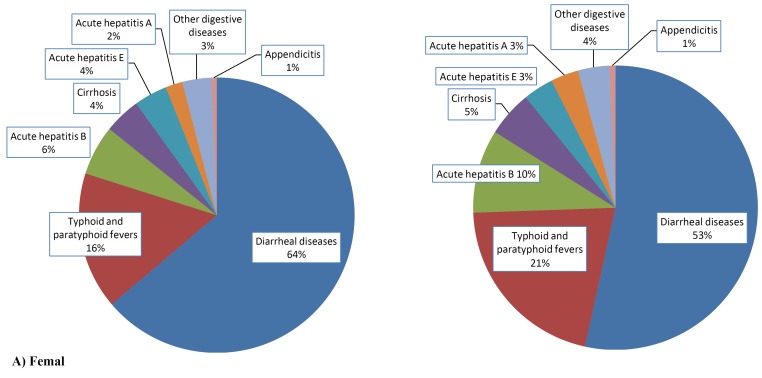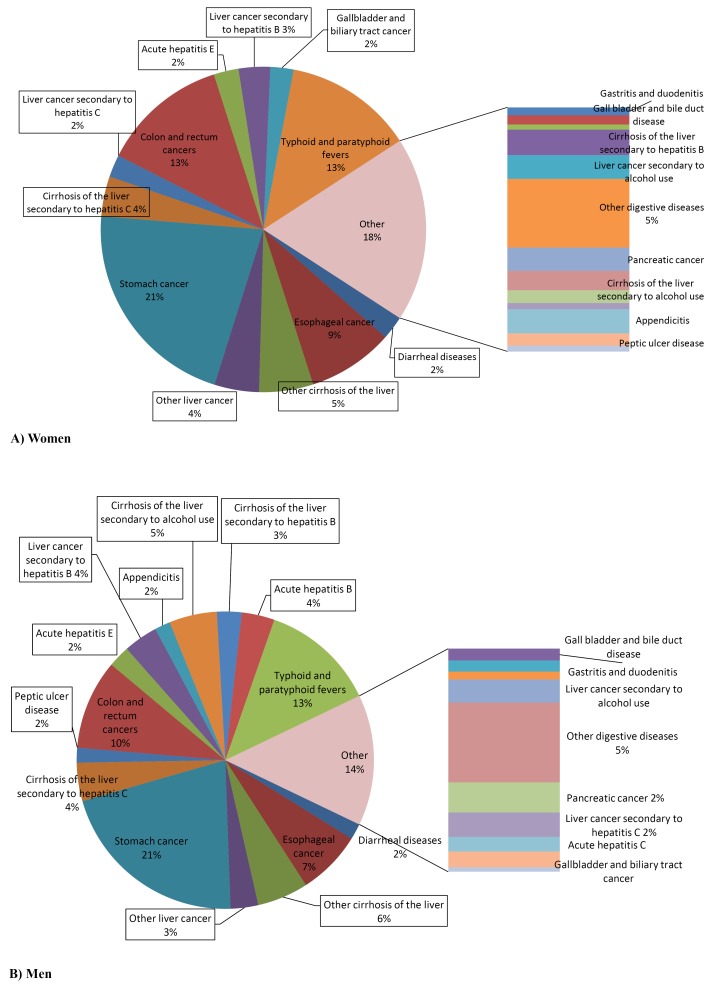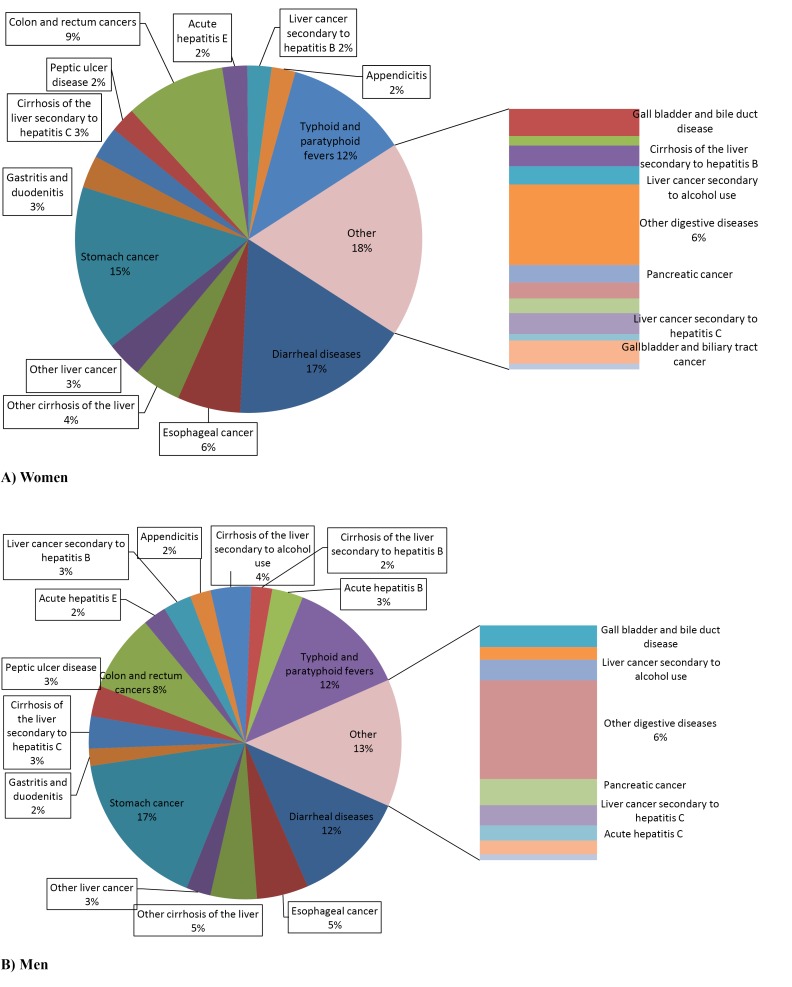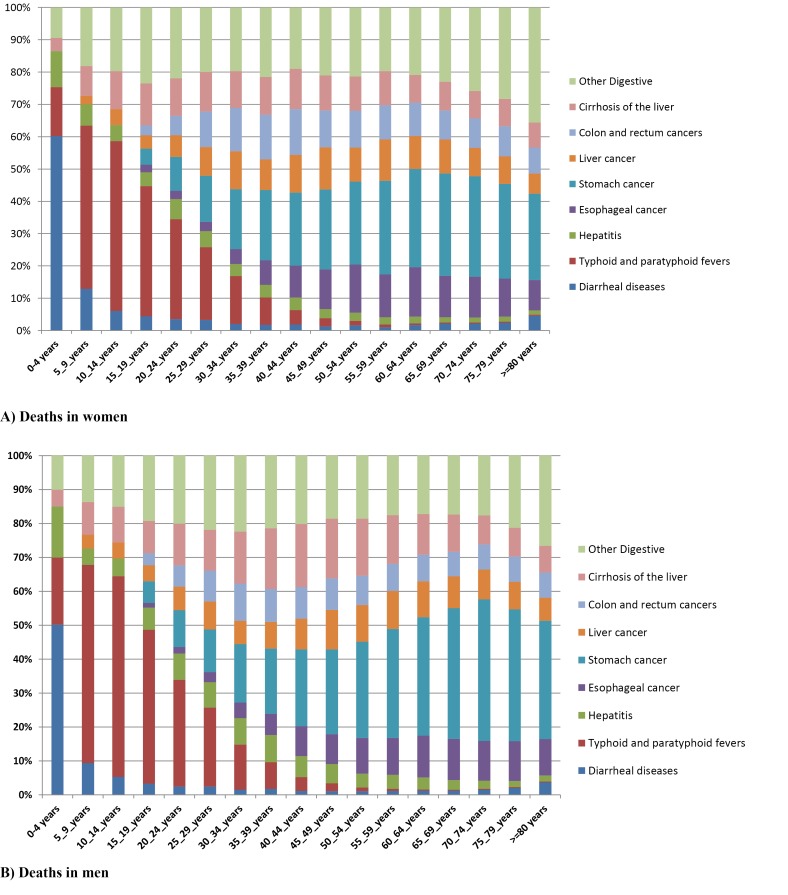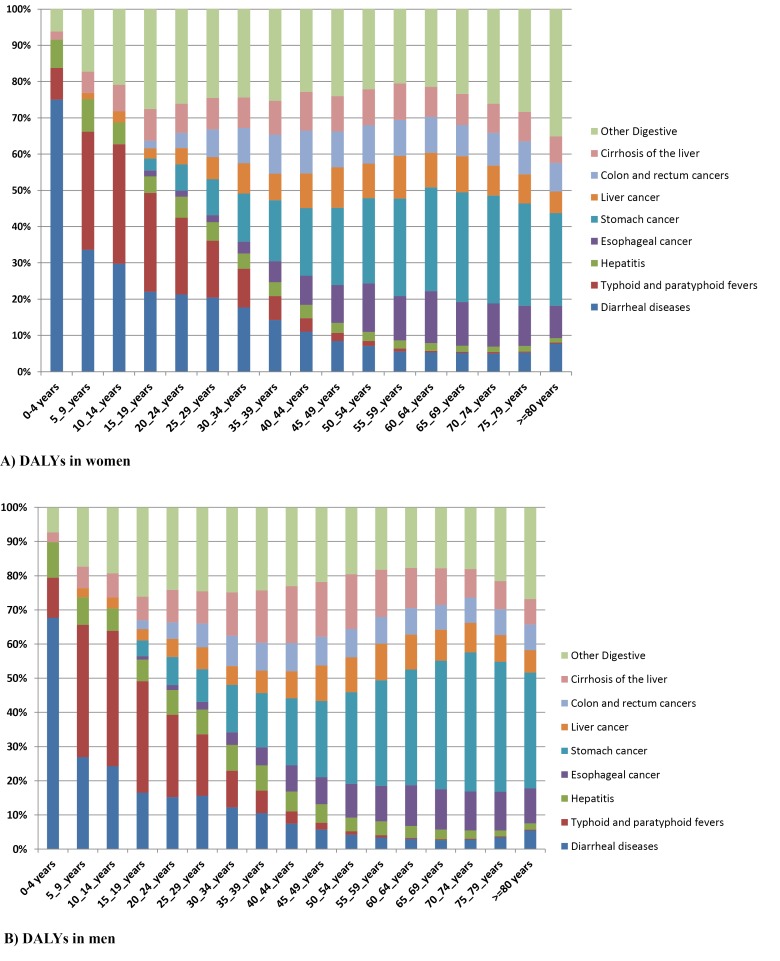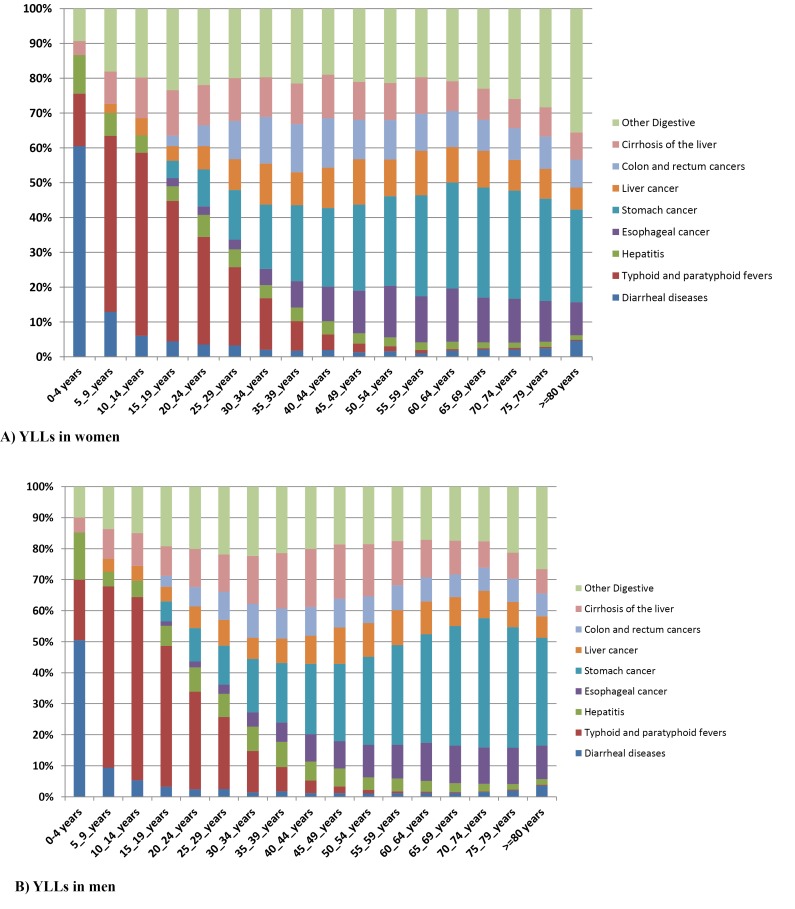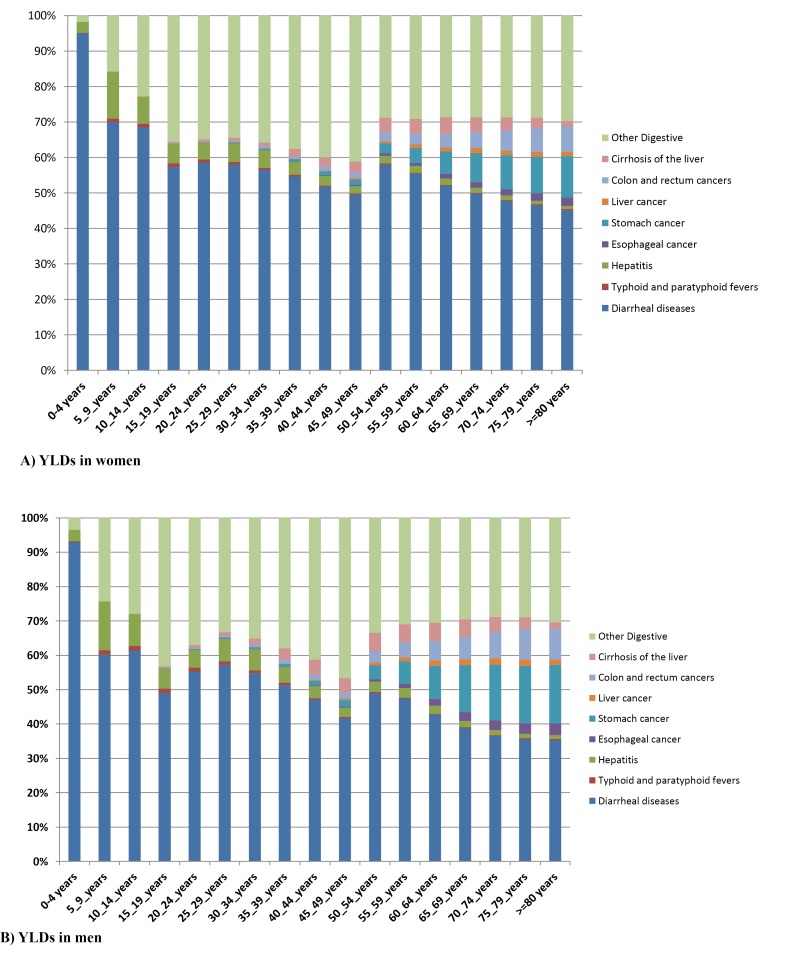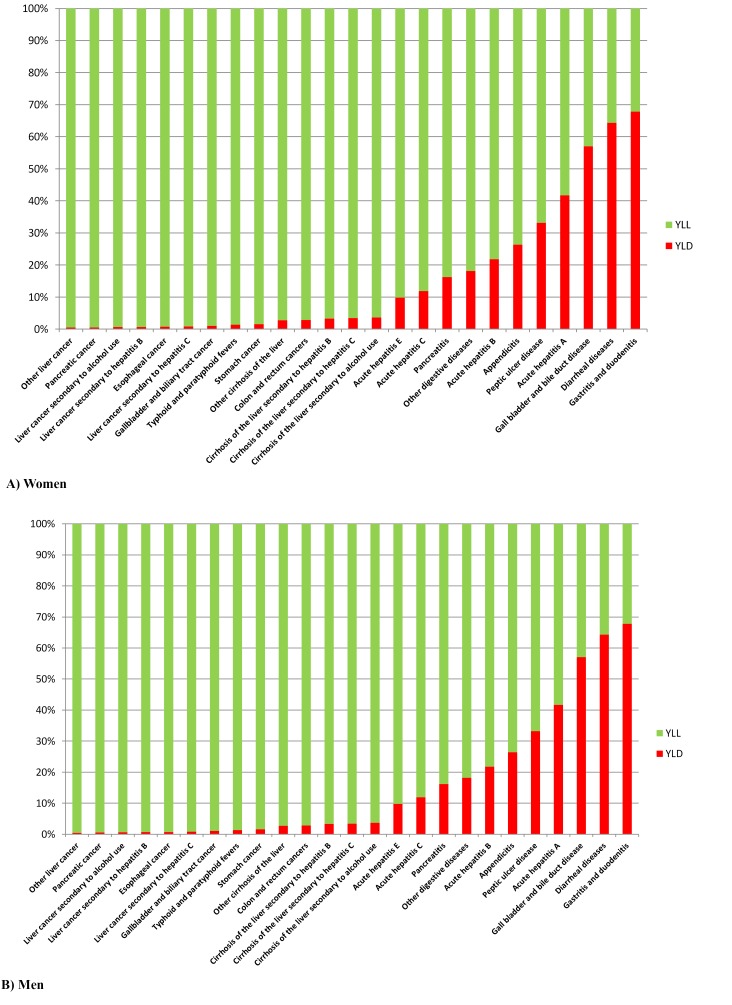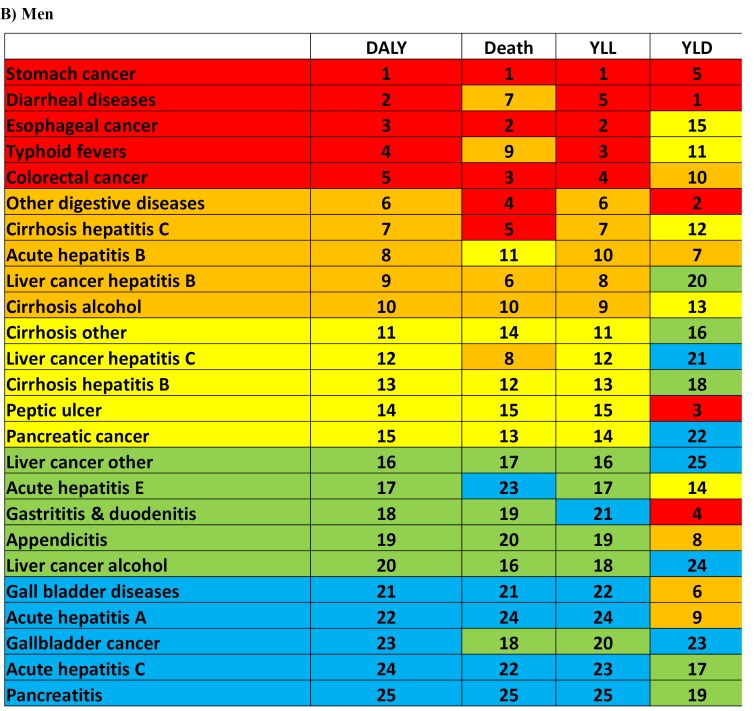Abstract
BACKGROUND
Gastrointestinal and liver diseases (GILD) constitute a noteworthy portion of causes of death and disability in Iran. However, data on their prevalence and burden is sparse in Iran. The Global Burden of Disease (GBD) study in 2010 has provided invaluable comprehensive data on the burden of GILD in Iran.
METHODS
Estimations of death, years of life lost due to premature death (YLL), years of life lost due to disability (YLD), disability-adjusted life years (DALY), life expectancy, and healthy life expectancy have been reported for 291 diseases, 67 risk factors, 1160 sequelae, for both sexes and 19 age groups, form 1990 to 2010 for 187 countries. In the current paper, 5 major categories of gastrointestinal (GI) and liver diseases have been investigated as follows: GI infectious diseases, GI and liver cancers, liver infections, chronic end stage liver disease, and other digestive diseases.
RESULTS
Among women, 7.6% of all deaths and 3.9% of all DALYs were due to digestive and liver diseases in 2010. The respective figures in men were 7.8% of deaths and 4.6% of DALYs. The most important cause of death among children under 5 is diarrhea. Among adults between 15 to 49 years old, the main causes of death are GI and liver cancers and cirrhosis, while diarrhea still remains a major cause of DALY. Among adults 50 years and above, GI and liver cancers and cirrhosis are the main causes of both deaths and DALYs. Gastritis and duodenitis, diarrheal diseases, gall bladder and bile duct diseases, acute hepatitis A, peptic ulcer disease, appendicitis, and acute hepatitis A mainly cause disability rather than death.
CONCLUSION
GBD study provides invaluable source of data on burden of GILD in Iran. However, there exist limitations, namely overestimation of burden of liver cancer and underestimation of the burden of GI diseases that are usually diagnosed in outpatient settings. The collaboration of scientists across the world and specifically those from developing countries is necessary for improving the accuracy of future updates of GBD in these countries.
Keywords: Gastrointestinal disease, liver disease, Mortality, Disability, Burden, Iran
INTRODUCTION
Gastrointestinal and liver diseases (GILD) are major causes of disability and mortality across the world. Naghavi et al. reported that GILD ranked 7th among top 10 major groups of illness imposing burden on Iranians in 2003.1 Additionally, gastrointestinal and hepato-billiary malignancies account for more than 40% of all cancer prevalence and mortality in Iran 2 and constitute a major proportion of all deaths due to GILD.2 Gastric cancer alone constitutes 20% of cancer mortality in Iran.2 Gastrointestinal and liver malignancies along with chronic liver disease constitute the main causes of GILD hospitalization and deaths in Iran.3,4 Apart from mortality, gastroesophageal reflux disease, irritable bowel syndrome, peptic ulcer disease, non-alcoholic steatohepatitis, hepatitis B, gall stone disease, and non-ulcer dyspepsia are the most common GILD outpatient diagnoses.3-5
In spite of the above mentioned rough and scattered estimates regarding epidemiology of different GILD diseases in Iran, there is no comprehensive estimate for burden of this category of diseases at national level. The Global Burden of Disease (GBD) study was the first attempt to quantify health status and health loss at global, regional, and national level. GBD 2010 was led by the Institute of Health Metrics and Evaluation in the University of Washington. Over 400 scientists from 50 countries have collaborated in this project. The utmost characteristic of GBD is the unique metrics that have been developed, making it possible to compare the estimation of health status across time and place. In the current paper, we have reported a summary of the findings of GBD 2010 for GILD in Iran.6-17
MATERIALS AND METHODS
Methods used in Global Burden of Disease (GBD) study in 2010 have been described in details elsewhere.8 Estimations have been done for 291 diseases, 67 risk factors, 1160 sequelae, for both sexes and 19 age groups, from 1990 to 2010 for 187 countries. A sequela is the direct consequence of a disease that causes disability and diminishes the quality of life. Each disease may have several sequelae and each sequela may be common between several diseases. Data from all countries have been collected and aggregated in a standardized format.
Several measures have been utilized in GBD to report health and disease: all-cause and cause-specific mortality, years of life lost due to premature death (YLL), years of life lost due to disability (YLD), and disability adjusted life years (DALY). To estimate the number of cause-specific deaths, data of the vital registration system and death registry, and verbal autopsy studies have been used. Deaths have been reported as numbers, rates, and fractions. Mortality in Iran was estimated primarily based on data from Iran. Later, estimates were further informed based on a subset of country-level covariates as well as input data from regional, super-region and global levels. Examples of these covariates included: income per capita, education, access to health system, smoking, and a number of dietary and metabolic risk factors such as mean body mass index. Three methods were used for modeling for each combination of covariates and outcome: linear, space-time smoothing, and Guassian process regression. The performance of each model was evaluated by the final ensemble method. YLL was calculated by multiplying the number of cause-specific deaths by the standard life expectancy for each country-age-sex group. YLDs were calculated by multiplying the prevalence of each sequela by its disability weight that was estimated in a separate study. Disability weights were calculated for each sequela based on internet base survey at global level. A systematic review was performed for each disease and epidemiological measures of each disease were extracted. A Bayesian meta-regression tool (DisMod-MR) was used to estimate the prevalence of sequelae. Incidence, prevalence, case fatality, remission, and cause-specific mortality rates were used as input data in DisMod-MR.
DALYs are calculated by adding YLLs and YLDs for each country-age-sex group. Age standardization was done using WHO standard population. A Monte Carlo method was used to estimate uncertainty intervals.
In the current paper, we have presented the above mentioned metrics of health for gastrointestinal (GI) and liver diseases in Iran in 2010. We have included 5 major categories of disease as follows: GI infectious diseases, GI and liver cancers, liver infections, chronic end stage liver disease, other digestive diseases. Infectious diseases of GI tract consist of diarrhea, typhoid and paratyphoid fevers. Cancers include esophageal, stomach, colorectal, liver, gall bladder, and pancreatic cancers. Liver infections include acute hepatitis A, B, C, and E. Chronic end stage liver disease (cirrhosis) may be secondary to hepatitis B or C, alcohol, or other causes including autoimmune hepatitis. Other digestive diseases consist of gastritis and duodenitis and peptic ulcer disease diagnosed based on pathology, appendicitis, paralytic ileus and intestinal obstruction without hernia, inguinal and femoral hernia, non-infective inflammatory bowel disease, vascular disorders of intestine, gall bladder and bile duct disease, pancreatitis, and yet other unspecified digestive diseases.
RESULTS
A total of 128,046 (111,220-148,610) deaths and 8,415,359 (7,394,893-9,502,928) DALYs have occurred in women in 2010. The respective figures for men were 223,768 (204,561-256,175) deaths and 10,986,027 (9,879,326-12,381,059) DALYs. Among women, 7.6% of all deaths and 3.9% of all DALYs were due to digestive and liver diseases. The respective figures in men were 7.8% of deaths and 4.6% of DALYs. Table 1 demonstrates the number of total deaths, YLLs, YLDs, and DALYs for all ages separately among men and women, for each of the 25 gastrointestinal and hepatic causes of death and disability in 2010.
Table 1 . Total DALYs, YLDs, YLLs, and deaths due to GILD in 2010 in Iran. A. Women .
| DALYs | Lower 95%UI | Upper 95%UI | YLDs | Lower 95%UI | Upper 95%UI | YLLs | Lower 95% UI | Upper 95%UI | Deaths | Lower 95%UI | Upper 95%UI | |
| Stomach cancer | 55751.6 | 29309.2 | 81707.0 | 883.9 | 397.4 | 1475.7 | 54867.8 | 28382.6 | 81088.1 | 2520.3 | 1375.8 | 3905.9 |
| Esophageal cancer | 23823.5 | 15315.1 | 38285.7 | 181.3 | 66.1 | 386.4 | 23642.1 | 15147.9 | 38081.7 | 1054.3 | 700.3 | 1655.8 |
| Colorectal cancer | 23148.1 | 16611.7 | 30351.9 | 654.5 | 375.0 | 1042.6 | 22493.7 | 16046.1 | 29658.6 | 897.8 | 665.3 | 1172.2 |
| Other digestive diseases | 14693.1 | 4827.3 | 22064.4 | 2669.6 | 1559.3 | 4745.0 | 12023.5 | 2609.2 | 18891.9 | 549.0 | 159.4 | 867.8 |
| Diarrheal diseases | 76121.6 | 52825.5 | 107444.6 | 48977.1 | 29408.2 | 75605.9 | 27144.5 | 16254.6 | 47498.3 | 496.7 | 344.7 | 747.8 |
| Cirrhosis hepatitis C | 9790.2 | 7377.0 | 13875.3 | 338.3 | 130.6 | 652.6 | 9451.8 | 7079.4 | 13444.1 | 410.4 | 304.9 | 579.8 |
| Liver cancer hepatitis C | 7838.6 | 3902.7 | 11237.6 | 63.9 | 10.6 | 154.5 | 7774.7 | 3837.1 | 11143.8 | 365.9 | 180.9 | 512.6 |
| Typhoid fevers | 22920.5 | 3216.8 | 46874.5 | 311.2 | 48.4 | 853.2 | 22609.3 | 2811.1 | 46728.6 | 364.0 | 46.2 | 755.7 |
| Liver cancer hepatitis B | 6174.9 | 3012.5 | 8948.5 | 43.3 | 3.4 | 119.6 | 6131.6 | 2986.5 | 8902.2 | 242.8 | 120.4 | 340.0 |
| Gallbladder cancer | 5255.7 | 2515.1 | 8977.2 | 55.2 | 6.7 | 152.1 | 5200.5 | 2467.0 | 8951.6 | 224.8 | 110.7 | 356.2 |
| Pancreatic cancer | 5066.5 | 2970.1 | 7831.2 | 26.0 | 0.0 | 86.9 | 5040.5 | 2938.0 | 7811.0 | 222.4 | 130.7 | 348.4 |
| Peptic ulcer | 5335.8 | 2394.1 | 11226.5 | 1770.6 | 196.0 | 7416.5 | 3565.2 | 1584.2 | 4750.2 | 210.4 | 91.4 | 311.7 |
| Cirrhosis other | 8746.4 | 6320.3 | 12289.3 | 241.3 | 68.1 | 511.6 | 8505.2 | 6089.2 | 11995.1 | 209.1 | 155.5 | 281.8 |
| Cirrhosis hepatitis B | 4360.7 | 3268.9 | 5990.2 | 145.3 | 45.7 | 320.2 | 4215.4 | 3104.9 | 5843.5 | 176.5 | 130.0 | 247.5 |
| Liver cancer other | 5337.3 | 2276.3 | 8436.6 | 26.2 | 0.0 | 105.4 | 5311.0 | 2262.4 | 8425.1 | 142.5 | 65.6 | 210.8 |
| Liver cancer alcohol | 2998.4 | 1431.5 | 4268.8 | 19.2 | 0.4 | 80.1 | 2979.2 | 1413.2 | 4245.8 | 114.0 | 56.6 | 157.0 |
| Gall bladder diseases | 4519.1 | 2824.5 | 7206.0 | 2578.4 | 1093.8 | 5128.8 | 1940.7 | 1321.7 | 2722.9 | 103.3 | 64.1 | 163.1 |
| Appendicitis | 4074.6 | 1712.9 | 6585.0 | 1074.7 | 246.4 | 2964.2 | 2999.9 | 954.6 | 4835.8 | 95.0 | 31.5 | 160.7 |
| Cirrhosis alcohol | 2394.6 | 1778.0 | 3340.7 | 87.6 | 15.7 | 210.0 | 2307.0 | 1700.8 | 3279.5 | 88.6 | 66.6 | 120.1 |
| Acute hepatitis B | 4532.3 | 2214.4 | 9284.3 | 988.3 | 56.0 | 3950.3 | 3544.0 | 1729.1 | 7761.1 | 81.2 | 48.3 | 147.1 |
| Acute hepatitis C | 1524.9 | 693.4 | 2668.1 | 181.4 | 38.3 | 383.3 | 1343.5 | 531.7 | 2468.6 | 67.1 | 20.0 | 136.7 |
| Gastrititis & duodenitis | 4664.0 | 2552.1 | 9490.4 | 3163.7 | 1274.6 | 7811.4 | 1500.3 | 886.2 | 2777.4 | 63.2 | 36.0 | 119.1 |
| Acute hepatitis E | 4497.5 | 2062.9 | 8870.6 | 442.7 | 96.1 | 1302.0 | 4054.8 | 1594.6 | 8545.6 | 62.7 | 24.5 | 133.0 |
| Acute hepatitis A | 2640.3 | 1292.2 | 5332.8 | 1101.6 | 452.4 | 2126.6 | 1538.8 | 496.1 | 3983.5 | 39.0 | 14.1 | 97.4 |
| Pancreatitis | 988.7 | 635.2 | 1537.7 | 160.3 | 9.8 | 495.4 | 828.4 | 551.7 | 1317.3 | 36.5 | 24.2 | 55.6 |
| B. Men | DALYs | Lower 95%UI | Upper 95%UI | YLDs | Lower 95%UI | Upper 95%UI | YLLs | Lower 95% UI | Upper 95%UI | Deaths | Lower 95%UI | Upper 95%UI |
| Stomach cancer | 116370.5 | 63222.4 | 150227.2 | 1588.6 | 785.5 | 2426.7 | 114781.9 | 61520.5 | 148856.6 | 5762.2 | 3110.0 | 7503.2 |
| Esophageal cancer | 37275.3 | 26876.9 | 57662.4 | 291.9 | 139.8 | 505.5 | 36983.4 | 26661.2 | 57396.7 | 1813.7 | 1332.7 | 2756.2 |
| Colorectal cancer | 31625.1 | 25168.0 | 40024.9 | 991.0 | 611.8 | 1415.4 | 30634.0 | 24338.2 | 38802.5 | 1320.2 | 1062.2 | 1661.4 |
| Other digestive diseases | 20062.3 | 6132.8 | 26344.3 | 3175.1 | 1725.9 | 5815.6 | 16887.2 | 3051.6 | 22834.7 | 736.6 | 159.9 | 1004.8 |
| Cirrhosis hepatitis C | 16285.7 | 12198.1 | 23390.7 | 360.8 | 147.7 | 703.0 | 15924.9 | 11822.6 | 22956.8 | 674.7 | 500.0 | 941.4 |
| Liver cancer hepatitis B | 14008.5 | 7646.9 | 18468.6 | 85.6 | 19.6 | 193.6 | 13922.9 | 7596.6 | 18350.4 | 595.4 | 305.5 | 788.1 |
| Diarrheal diseases | 73707.4 | 52075.9 | 103276.3 | 47281.2 | 29545.2 | 72130.7 | 26426.2 | 16922.5 | 41736.3 | 562.6 | 413.2 | 763.7 |
| Liver cancer hepatitis C | 11152.1 | 5832.0 | 14627.6 | 74.4 | 18.1 | 160.6 | 11077.7 | 5765.3 | 14579.2 | 547.4 | 267.9 | 728.0 |
| Typhoid fevers | 32283.0 | 4008.6 | 66722.6 | 413.8 | 83.2 | 1083.6 | 31869.1 | 3490.4 | 66135.9 | 512.3 | 56.7 | 1063.4 |
| Cirrhosis alcohol | 13548.7 | 10369.1 | 19391.3 | 330.7 | 113.2 | 674.1 | 13218.0 | 10071.0 | 19128.2 | 501.3 | 378.9 | 711.5 |
| Acute hepatitis B | 14761.8 | 8750.8 | 27343.8 | 1565.6 | 79.1 | 6012.6 | 13196.2 | 7675.0 | 25971.0 | 408.4 | 256.2 | 700.3 |
| Cirrhosis hepatitis B | 9712.4 | 7093.1 | 14238.9 | 219.3 | 68.9 | 457.3 | 9493.1 | 6838.5 | 14007.6 | 390.1 | 282.6 | 561.1 |
| Pancreatic cancer | 8519.4 | 5445.0 | 11235.0 | 48.0 | 4.3 | 132.3 | 8471.4 | 5413.8 | 11202.2 | 381.3 | 240.0 | 494.9 |
| Cirrhosis other | 13440.1 | 9926.8 | 18470.4 | 282.3 | 81.0 | 585.3 | 13157.8 | 9599.6 | 18259.8 | 350.5 | 261.1 | 488.4 |
| Peptic ulcer | 9483.5 | 4358.9 | 17439.4 | 2766.4 | 407.6 | 10442.2 | 6717.0 | 2797.1 | 8684.5 | 347.0 | 147.2 | 470.1 |
| Liver cancer alcohol | 4729.1 | 2589.6 | 6263.0 | 28.8 | 1.0 | 96.6 | 4700.4 | 2572.0 | 6239.4 | 196.1 | 99.3 | 258.9 |
| Liver cancer other | 6199.0 | 3502.4 | 8656.0 | 26.3 | 0.0 | 101.0 | 6172.7 | 3461.3 | 8626.7 | 178.2 | 96.4 | 237.3 |
| Gallbladder cancer | 3265.9 | 1719.3 | 5430.1 | 35.2 | 1.8 | 109.6 | 3230.6 | 1690.0 | 5379.0 | 141.0 | 79.0 | 219.0 |
| Gastrititis & duodenitis | 5126.1 | 3164.1 | 8263.6 | 2270.8 | 1075.4 | 4449.0 | 2855.3 | 1625.2 | 5362.1 | 129.6 | 69.1 | 248.1 |
| Appendicitis | 5078.9 | 2150.4 | 8670.0 | 1201.3 | 270.3 | 3306.7 | 3877.6 | 1259.6 | 6890.9 | 121.9 | 39.4 | 227.3 |
| Gall bladder diseases | 3953.6 | 2699.5 | 5643.8 | 1586.6 | 655.9 | 3165.7 | 2367.1 | 1575.3 | 3201.7 | 108.3 | 72.4 | 160.5 |
| Acute hepatitis C | 2554.2 | 1576.4 | 4185.2 | 223.1 | 43.2 | 476.4 | 2331.2 | 1367.5 | 3999.4 | 88.1 | 48.9 | 145.7 |
| Acute hepatitis E | 5230.9 | 2184.9 | 11063.9 | 307.9 | 55.4 | 892.6 | 4923.0 | 1845.6 | 10684.6 | 77.4 | 28.9 | 167.9 |
| Acute hepatitis A | 3282.5 | 1311.9 | 9413.2 | 1144.0 | 447.8 | 2197.5 | 2138.4 | 602.3 | 7926.9 | 50.2 | 20.0 | 162.4 |
| Pancreatitis | 943.5 | 610.7 | 1475.0 | 210.4 | 12.3 | 616.5 | 733.0 | 516.9 | 1132.7 | 32.7 | 22.0 | 49.7 |
Figure 1 demonstrates the main gastrointestinal and hepatic causes of death in males and females under 5 years. As can be noticed, the most important GILD cause of death among children under 5 is diarrhea. The next two most important causes are typhoid and paratyphoid fevers and acute hepatitis B.
Fig. 1 .
The main gastrointestinal and hepatic causes of death in females and males under 5 years in Iran.
Figure 2 demonstrates the main GILD causes of death among men and women between 15 to 49 years of age and figure 3 shows the main causes of DALYs in this age group. Diarrheal diseases are still the major causes of DALYs in adult group between 15 and 49 years old, but GI deaths are mostly caused by main GI cancers: cancers of stomach, esophagus, colon and rectum, and liver. End stage liver disease or cirrhosis due to various etiologies has a significant role in the number of deaths and DALYs. Gastritis and duodenitis, peptic ulcer disease, and appendicitis are mainly responsible for DALYs compared to deaths.
Fig. 2 .
The main gastrointestinal and hepatic causes of death in females and males 15 to 49 years old.
Fig. 3 .
The main gastrointestinal and hepatic causes of DALY in females and males 15 to 49 years old.
Figure 4 shows the main GILD causes of DALYs among the elderly aged 50 years and above. All groups of GI and liver cancers have replaced most other GI diseases. Overall, GI and liver cancers constitute 69.5% of total GI DALYs in women and 71.4% in men aged 50 years and older.
Fig. 4 .
The main gastrointestinal and hepatic causes of DALY in females and males 50 years old and above.
Figures 5 to 8 show the etiologic pattern of GILD deaths, YLLs, YLDs, and DALYs for men and women by age groups. Diarrheal diseases and typhoid and paratyphoid fevers are the main causes of deaths and YLLs among children and adolescents, but they are substituted by cancers, mainly the cancers of stomach and esophagus among older adults. Cirrhosis as the cause of death and YLL is distributed evenly among different age groups of adults aged 25 year and above. The pattern of YLDs is quite different. Diarrheal disease are the most important contributor of YLDs in all ages and both sexes. Among adults aged 50 years and more, cancers of stomach and colon and rectum are more prominent causes of YLDs than other GI cancers.
Fig. 5 .
Etiologic pattern of deaths in men and women by age groups.
Fig. 8 .
Etiologic pattern of DALYs in men and women by age groups.
Fig. 6 .
Etiologic pattern of YLLs in men and women by age groups.
Fig. 7 .
Etiologic pattern of YLDs in men and women by age groups.
Figure 9 shows the fraction of YLLs and YLDs for all 25 GI diseases investigated in this study. Gastritis and duodenitis, diarrheal diseases, gall bladder and bile duct diseases, acute hepatitis A, peptic ulcer disease, appendicitis, acute hepatitis B, and pancreatitis are the main GI diseases that cause more disability than death. The pattern is similar between men and women.
Fig. 9 .
The fraction of YLLs and YLDs for all 25 gastrointestinal and hepatic diseases.
Finally, in figure 10, GI causes are ranked based on their DALYs among all ages separately in men and women. Diarrheal diseases are the first cause of DALYs and YLDs but the 5th cause of death in women. Among men, stomach cancer is the first cause of DALY. Diarrheal diseases, which rank 2nd in DALYs and 1st in YLDs, are the 7th cause of death in men. Stomach cancer, esophageal cancer, and colorectal cancers are among the top 5 causes of DALY and death in both men and women. Peptic ulcer disease, gastritis and duodenitis, gall bladder diseases, acute hepatitis A and B, and appendicitis are among the top 10 causes of YLDs in both women and men.
Fig. 10.
Gastrointestinal and hepato-billiary causes ranked based on their DALYs among all ages separately in women and men.
A).
Women
B).
Men
DISCUSSION
Findings of GBD 2010 demonstrate different pattern of GILD across sex and age groups and different contribution of separate diseases to mortality and disability. Results demonstrate that intestinal infections although declined very sharply during last 3 decades in Iran18 along with acute hepatitis A, B, and E, are still the most prominent GILD causes of death and disability in children under 5 years of age. Among adults, acute and infectious diseases have been largely replaced by chronic non-communicable diseases of the gastrointestinal tract and liver, mainly GI and hepatic cancers and cirrhosis. Other gastrointestinal diseases including gastritis and duodenitis, peptic ulcer disease, inflammatory bowel disease, functional and autoimmune GI and liver disease and appendicitis have no significant contribution to mortality and mainly cause disability.
A major challenge that GBD 2010 faces is the fact that the outpatient data in particular are generally not available in developing countries and in many cases such as Iran, the existing data is of poor quality and under-reported. An example is reporting gastritis or duodenitis as major etiologies of disability in Iran. Multi-cause estimation models based on poor quality data sources such as hospital and vital registry information have been used to overcome this shortcoming. However, it seems that errors still exist. The local data published from Iran during the last decade implies that the major causes of disability from GILD in Iran are actually gastroesophageal reflux disease (GERD)5, irritable bowel syndrome (IBS)4,19, inflammatory bowel disease (IBD)20-23, non-alcoholic steatohepatitis24,25, chronic active and inactive hepatitis B26, and gall stone disease3,4 rather than gastritis and duodenitis These major causes of disability are relatively the same across many developing countries and outpatient data should be included in later iterations of GBD.
This study also revealed that the five leading gastrointestinal causes of death in order of frequency were: gastric cancer, esophageal cancer, colorectal cancer, cirrhosis, and liver cancer. Another probable error in GBD 2010 is the reported 4th rank of liver cancer among GI cancers in Iran. According to population based cancer registry data published recently, primary liver cancer is not among the first 10 common cancers in Iran and the rate is actually lowest among all countries in the region.2,27-31 Most of the so-called liver cancers are actually metastatic cancers with primary tumor mainly in GI tract. This is due to the fact that there is no screening program for GI cancers in the country and most Iranian patients with primary GI cancer refer to physician when the tumor is already in advanced stage. This problem exists in many developing and even developed countries and GBD study has tried to correct it by redistribution of unspecified cancer sites.
Another controversy regarding liver cancer is related to its etiology. Evidence shows that the rate of HBV induced hepatocellular carcinoma is 3 to 4 times more than the rate induced by HCV. However, the results of GBD 2010 are reverse. This finding may be due to impact of regional data on national estimates in Iran, which may be biased towards higher burden of liver cancer secondary to HCV. The next controversy is related to alcohol as one of the etiologies of liver cancer and cirrhosis. The GBD results show that less than 0.5% of deaths and DALYs in women is secondary to alcohol use, which makes sense. The percentage of deaths and DALYs in men secondary to alcohol is higher (4% to 5%), which makes sense again. However, it may seem to be overestimated when it is compared with outpatient data. The fact is alcohol use generally reported in sparse studies is underestimated in Iran due to legal and religious bans, and the results of GBD may not be overestimated. Population based studies are mandatory to investigate the level and impact of alcohol use in Iran.
The ranking of GILDs presented in figure 10 very much confirms the previously mentioned results. Diarrhea, though a main cause of DALY, is not the main cause of death in Iran, neither in women nor in men. Cancers have the highest ranks, especially in terms of deaths and YLLs, while gastritis, duodenitis, and peptic ulcer are mainly the top causes of YLD in both sexes. The pattern of rankings is quite similar in terms of deaths and DALYs. The patterns are also similar between men and women, except for alcohol induced cirrhosis and liver cancer, which has an evident higher rank in men.
Hospital data may be another source for estimating the prevalence and burden of those diseases that finally end in hospitalization. Shariati hospital is the most well-known referral center for GILD in Iran. From 2000 to 2009 the five leading causes of hospitalization in the GILD ward were: liver cirrhosis, hepatitis, peptic ulcer disease, cholicystitis, cholangitis, and colorectal cancer.3,4 IBD, IBS, and gall stone disease have been recently shown to be increasing.19-23 However, hospital data, especially in the case of Shariati hospital which is a specialized referral center in Iran, may not be a good proxy for prevalence and burden of diseases at national scale. The same happens in clinics. GILDs detected in outpatient setting of gastrointestinal diseases don’t cover children and adolsecnts and are limited to adults. Therefore the pattern of GILDs that gastroenterologists observe in practice is quite different from figures estimated in GBD. Likewise as mentioned above, fatal GILDs usually don’t live long enough to refer to a referral center in the capital of Iran and most cases of GILD that gastroentrologists encounter in practice are rare and non-fatal diseases of the gastrointestinal and hepatic system.
GBD 2010 has so far been the largest and most comprehensive epidemiologic study on major injuries and diseases, which for the first time provided a source of reliable data about most of prevailing diseases and their well known risk factors at global level. It also developed innovative metrics that measure not only the illness as a combination of death and disability, but also “health”, and so makes it possible to compare health status in several nations in different counties of the world at different times. GBD metrics measure both disease occurrences and death events. Since many countries are at different stages of epidemiologic transition, the GBD estimates should be updated using more reliable data, especially for developing countries, in order to overcome the limitations.
In countries with no data and those with high quality data, GBD researchers had no problem because in first case, there is no source for comparison and every critic is based on estimation. In the second case, all of GBD estimations follow the reliable existing data. However, in countries with scarce and inconsistent data, there is a potential source of bias that may be imposed on estimations. GBD researchers have used all data and all of their models go between these two types of data. They had to drop data only if these were biased. Yet, dropping data cannot be done without evidence and it will not be a scientific act.
Scientists from developing countries need to collaborate more closely with GBD team in order to provide more accurate estimates. They also need to become active in the study and surveillance of the diseases and the risk factors for which, high quality data is not available at country level.
GBD 2010, GBD 2013 and the future 2015 updates will provide a very good source for health policy makers to use the data for better policy making and for scientists and researchers to focus on the most common etiologies of disease and disability and to better measure the effect of their interventions on preventing disease, death, and disability.
CONFLICT OF INTEREST
The authors declare no conflict of interest related to this work.
FUNDING
This study was supported by grants from Iranian association of gastroenterology and Hepatology.
Please cite this paper as:
Malekzadeh F, Ghajarieh Sepanlou S, Poustchi H, Naghavi M, Forouzanfar MH, Shahraz S, Moradi-Lakeh M, Malekzadeh R. Burden of Gastrointestinal and Liver Diseases in Iran: Estimates Based on the Global Burden of Disease, Injuries, and Risk Factors Study, 2010. Middle East J Dig Dis 2015;7:138-54.
References
- 1.Naghavi M, Abolhassani F, Pourmalek F, Lakeh M, Jafari N, Vaseghi S. et al. The burden of disease and injury in Iran 2003. Popul Health Metr. 2009;7:9. doi: 10.1186/1478-7954-7-9. [DOI] [PMC free article] [PubMed] [Google Scholar]
- 2.Sadjadi A, Nouraie M, Mohagheghi MA, Mousavi-Jarrahi A, Malekezadeh R, Parkin DM. Cancer occurrence in Iran in 2002, an international perspective. Asian Pac J Cancer Prev. 2005;6:359–63. [PubMed] [Google Scholar]
- 3.Abedian S, Asl Soleimani H, Saberifiroozi M, Malekzadeh R. Common Digestive and Liver Diseases among 5880 Patients Admitted to Shariati Hospital,Tehran,Iran during 2000-2009. Middle East J Dig Dis. 2012;4:28–33. [PMC free article] [PubMed] [Google Scholar]
- 4.Ganji A, Malekzadeh F, Safavi M, Nasseri Moghaddam S, Nouraie M, Merat S. et al. Digestive and Liver Disease Statistics in Iran. Middle East J Dig Dis. 2009;1:56–62. [Google Scholar]
- 5.Sepanlou S, Khademi H, Abdollahzadeh N, Noori F, Malekzadeh F, Malekzadeh R. Time Trends of Gastro-esophageal Reflux Disease (GERD) and Peptic Ulcer Disease (PUD) in Iran. Middle East J Dig Dis. 2010;2:78–83. [PMC free article] [PubMed] [Google Scholar]
- 6.Lozano R, Naghavi M, Foreman K, Lim S, Shibuya K, Aboyans V. et al. Global and regional mortality from 235 causes of death for 20 age groups in 1990 and 2010: a systematic analysis for the Global Burden of Disease Study 2010. Lancet. 2012;380:2095–128. doi: 10.1016/S0140-6736(12)61728-0. [DOI] [PMC free article] [PubMed] [Google Scholar]
- 7.Murray CJ, Ezzati M, Flaxman AD, Lim S, Lozano R, Michaud C. et al. GBD 2010: a multi-investigator collaboration for global comparative descriptive epidemiology. Lancet. 2012;380:2055–8. doi: 10.1016/S0140-6736(12)62134-5. [DOI] [PubMed] [Google Scholar]
- 8.Murray CJ, Ezzati M, Flaxman AD, Lim S, Lozano R. et al. GBD 2010: design, definitions, and metrics. Lancet. 2012;380:2063–2066. doi: 10.1016/S0140-6736(12)61899-6. [DOI] [PubMed] [Google Scholar]
- 9.Murray CJ, Vos T, Lozano R, Naghavi M, Flaxman AD, Michaud C. et al. Disability-adjusted life years (DALYs) for 291 diseases and injuries in 21 regions, 1990-2010: a systematic analysis for the Global Burden of Disease Study 2010. Lancet. 2012;380:2197–223. doi: 10.1016/S0140-6736(12)61689-4. [DOI] [PubMed] [Google Scholar]
- 10.Salomon JA, Vos T, Hogan DR, Gagnon M, Naghavi M, Mokdad A. et al. Common values in assessing health outcomes from disease and injury: disability weights measurement study for the Global Burden of Disease Study 2010. Lancet. 2012;380:2129–43. doi: 10.1016/S0140-6736(12)61680-8. [DOI] [PMC free article] [PubMed] [Google Scholar]
- 11.Salomon JA, Wang H, Freeman MK, Vos T, Flaxman AD, Lopez AD. et al. Healthy life expectancy for 187 countries, 1990-2010: a systematic analysis for the Global Burden Disease Study 2010. Lancet. 2012;380:2144–62. doi: 10.1016/S0140-6736(12)61690-0. [DOI] [PubMed] [Google Scholar]
- 12.Vos T, Flaxman AD, Naghavi M, Lozano R, Michaud C, Ezzati M. et al. Years lived with disability (YLDs) for 1160 sequelae of 289 diseases and injuries 1990-2010: a systematic analysis for the Global Burden of Disease Study 2010. Lancet. 2012;380:2163–96. doi: 10.1016/S0140-6736(12)61729-2. [DOI] [PMC free article] [PubMed] [Google Scholar]
- 13.Wang H, Dwyer-Lindgren L, Lofgren KT, Rajaratnam JK, Marcus JR, Levin-Rector A. et al. Age-specific and sex-specific mortality in 187 countries, 1970-2010: a systematic analysis for the Global Burden of Disease Study 2010. Lancet. 2012;380:2071–94. doi: 10.1016/S0140-6736(12)61719-X. [DOI] [PubMed] [Google Scholar]
- 14. Lopez AD, Mathers CD, Ezzati M, Jamison DT, Murray CJL, Measuring the Global Burden of Disease and Risk Factors, 1990-2001, in Global Burden of Disease and Risk Factors, A.D. Lopez, et al., Editors. 2006: Washington (DC).
- 15.Forouzanfar MH, Sepanlou SG, Shahraz S, Dicker D, Naghavi P, Pourmalek F. et al. Evaluating causes of death and morbidity in Iran, global burden of diseases, injuries, and risk factors study 2010. Arch Iran Med. 2014;17:304–20. [PubMed] [Google Scholar]
- 16.Naghavi M, Shahraz S, Sepanlou SG, Dicker D, Naghavi P, Pourmalek F. et al. Health transition in Iran toward chronic diseases based on results of Global Burden of Disease 2010. Arch Iran Med. 2014;17:321–35. [PubMed] [Google Scholar]
- 17.Shahraz S, Forouzanfar MH, Sepanlou SG, Dicker D, Naghavi P. et al. Population health and burden of disease profile of Iran among 20 countries in the region: from Afghanistan to Qatar and Lebanon. Arch Iran Med. 2014;17:336–42. [PubMed] [Google Scholar]
- 18.Massarrat S, Tahaghoghi-Mehrizi S. Iranian national health survey: a brief report. Arch Iran Med. 2002;5:73–9. [Google Scholar]
- 19.Vahedi H, Ansari R, Mir-Nasseri M, Jafari E. Irritable bowel syndrome: a review article. Middle East J Dig Dis. 2010;2:66–77. [PMC free article] [PubMed] [Google Scholar]
- 20.Aghazadeh R, Zali MR, Bahari A, Amin K, Ghahghaie F, Firouzi F. Inflammatory bowel disease in Iran: a review of 457 cases. J Gastroenterol Hepatol. 2005;20:1691–5. doi: 10.1111/j.1440-1746.2005.03905.x. [DOI] [PubMed] [Google Scholar]
- 21.Malekzadeh R, Varshosaz S, Merat S, Hadidchi S, Mirmajlesi S. et al. Cronn’s disease: a review of 140 cases from Iran. Iran J Med. 2000;25:138–43. [Google Scholar]
- 22.Malekzadeh R, Varshosaz S, Mirmajlesi S, Tavakoli H. Rising Incidence of Crohn’s disease in Iran over 1989–1999. Gastroenterology. 2000;118:A6172. [Google Scholar]
- 23.Vahedi H, Merat S, Momtahen S, Olfati G, Kazzazi AS. et al. Epidemiologic characteristics of 500 patients with inflammatory bowel disease in Iran studied from 2004 through 2007. Arch Iran Med. 2009;12:454–60. [PubMed] [Google Scholar]
- 24.Pourshams A, Malekzadeh R, Monavvari A, Akbari MR, Mohamadkhani A, Yarahmadi S. et al. Prevalence and etiology of persistently elevated alanine aminotransferase levels in healthy Iranian blood donors. J Gastroenterol Hepatol. 2005;20:229–33. doi: 10.1111/j.1440-1746.2004.03511.x. [DOI] [PubMed] [Google Scholar]
- 25.Sohrabpour A, Rezvan H, Amini-Kafiabad S, Dayhim M, Merat S, Pourshams A. Prevalence of Nonalcoholic Steatohepatitis in Iran: A Population based Study. Middle East J Dig Dis. 2010;2:14–9. [PMC free article] [PubMed] [Google Scholar]
- 26.Merat S, Rezvan H, Nouraie M, Jamali A, Assari S. et al. The prevalence of hepatitis B surface antigen and anti-hepatitis B core antibody in Iran: a population-based study. Arch Iran Med. 2009;12:225–31. [PubMed] [Google Scholar]
- 27.Ansari R, Mahdavinia M, Sadjadi A, Nouraie M, Kamangar F, Bishehsari F. et al. Incidence and age distribution of colorectal cancer in Iran: results of a population-based cancer registry. Cancer Lett. 2006;240:143–7. doi: 10.1016/j.canlet.2005.09.004. [DOI] [PubMed] [Google Scholar]
- 28.Sadjadi A, Malekzadeh R, Derakhshan MH, Sepehr A, Nouraie M. et al. Cancer occurrence in Ardabil: results of a population-based cancer registry from Iran. Int J Cancer. 2003;107:113–8. doi: 10.1002/ijc.11359. [DOI] [PubMed] [Google Scholar]
- 29.Poustchi H, Sepanlou S, Esmaili S, Mehrabi N, Ansarymoghadam A. Hepatocellular carcinoma in the world and the middle East. Middle East J Dig Dis. 2010;2:31–41. [PMC free article] [PubMed] [Google Scholar]
- 30.Moghaddam SD, Haghdoost AA, Hoseini SH, Ramazani R, Rezazadehkermani M. Incidence of hepatocellular carcinoma in southeast iran. Hepat Mon. 2010;10:270–4. [PMC free article] [PubMed] [Google Scholar]
- 31.Malekzadeh R, Bishehsari F, Mahdavinia M, Ansari R. Epidemiology and molecular genetics of colorectal cancer in iran: a review. Arch Iran Med. 2009;12:161–9. [PubMed] [Google Scholar]



